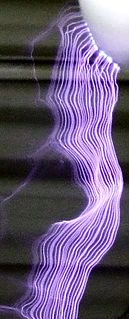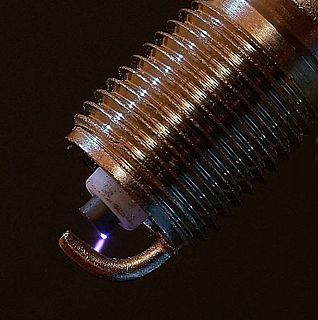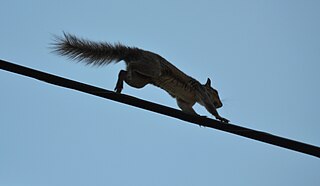 W
WElectrical breakdown or dielectric breakdown is a process that occurs when an electrical insulating material, subjected to a high enough voltage, suddenly becomes an electrical conductor and electric current flows through it. All insulating materials undergo breakdown when the electric field caused by an applied voltage exceeds the material's dielectric strength. The voltage at which a given insulating object becomes conductive is called its breakdown voltage and depends on its size and shape. Under sufficient electrical potential, electrical breakdown can occur within solids, liquids, gases or vacuum. However, the specific breakdown mechanisms are different for each kind of dielectric medium.
 W
WAn arc flash is the light and heat produced as part of an arc fault, a type of electrical explosion or discharge that results from a connection through air to ground or another voltage phase in an electrical system.
 W
WAvalanche breakdown is a phenomenon that can occur in both insulating and semiconducting materials. It is a form of electric current multiplication that can allow very large currents within materials which are otherwise good insulators. It is a type of electron avalanche. The avalanche process occurs when carriers in the transition region are accelerated by the electric field to energies sufficient to create mobile or free electron-hole pairs via collisions with bound electrons.
 W
WThe breakdown voltage of an insulator is the minimum voltage that causes a portion of an insulator to become electrically conductive.
 W
WA brush discharge is an electrical disruptive discharge similar to a corona discharge that takes place at an electrode with a high voltage applied to it, embedded in a nonconducting fluid, usually air. It is characterized by multiple luminous writhing sparks, plasma streamers composed of ionized air molecules, which repeatedly strike out from the electrode into the air, often with a crackling sound. The streamers spread out in a fan shape, giving it the appearance of a "brush".
 W
WA corona discharge is an electrical discharge caused by the ionization of a fluid such as air surrounding a conductor carrying a high voltage. It represents a local region where the air has undergone electrical breakdown and become conductive, allowing charge to continuously leak off the conductor into the air. A corona occurs at locations where the strength of the electric field around a conductor exceeds the dielectric strength of the air. It is often seen as a bluish glow in the air adjacent to pointed metal conductors carrying high voltages, and emits light by the same property as a gas discharge lamp.
 W
WA corona ring, also called an anti-corona ring, is a toroid of conductive material, usually metal, which is attached to a terminal or other irregular hardware piece of high voltage equipment. The role of the corona ring is to distribute the electric field gradient and lower its maximum values below the corona threshold, either preventing corona discharge entirely or transferring its destructive effects from the valuable hardware to the expendable ring. Corona rings are used on very high voltage power transmission insulators and switchgear, and on scientific research apparatus that generates high voltages. A very similar related device, the grading ring, is used around insulators.
 W
WAn electric spark is an abrupt electrical discharge that occurs when a sufficiently high electric field creates an ionized, electrically conductive channel through a normally-insulating medium, often air or other gases or gas mixtures. Michael Faraday described this phenomenon as "the beautiful flash of light attending the discharge of common electricity".
 W
WElectrical disruptions caused by squirrels are common and widespread, and can involve the disruption of power grids. It has been hypothesized that the threat to the internet, infrastructure and services posed by squirrels may exceed that posed by terrorists. Although many commentators have highlighted humorous aspects of the concern, squirrels have proven consistently able to cripple power grids in many countries, and the danger posed to the electrical grid from squirrels is ongoing and significant This has led to tabulations and maps compiled of the relevant data.
 W
WIn electrical engineering, treeing is an electrical pre-breakdown phenomenon in solid insulation. It is a damaging process due to partial discharges and progresses through the stressed dielectric insulation, in a path resembling the branches of a tree. Treeing of solid high-voltage cable insulation is a common breakdown mechanism and source of electrical faults in underground power cables.
 W
WElectrostatic discharge (ESD) is the sudden flow of electricity between two electrically charged objects cause by contact an electrical short, or dielectric breakdown. A buildup of static electricity can be caused by tribocharging or by electrostatic induction. The ESD occurs when differently-charged objects are brought close together or when the dielectric between them breaks down, often creating a visible spark.
 W
WThe Geiger–Müller tube or G–M tube is the sensing element of the Geiger counter instrument used for the detection of ionizing radiation. It was named after Hans Geiger, who invented the principle in 1908, and Walther Müller, who collaborated with Geiger in developing the technique further in 1928 to produce a practical tube that could detect a number of different radiation types.
 W
WAn induction coil or "spark coil" is a type of electrical transformer used to produce high-voltage pulses from a low-voltage direct current (DC) supply. To create the flux changes necessary to induce voltage in the secondary coil, the direct current in the primary coil is repeatedly interrupted by a vibrating mechanical contact called an interrupter. Invented in 1836 by Nicholas Callan, with additional research by Charles Grafton Page and others, the induction coil was the first type of transformer. It was widely used in x-ray machines, spark-gap radio transmitters, arc lighting and quack medical electrotherapy devices from the 1880s to the 1920s. Today its only common use is as the ignition coils in internal combustion engines and in physics education to demonstrate induction.
 W
WIonized-air glow is the fluorescent emission of characteristic blue–purple–violet light, often of a color called electric blue, by air subjected to an energy flux.
 W
WKirlian photography is a collection of photographic techniques used to capture the phenomenon of electrical coronal discharges. It is named after Semyon Kirlian, who, in 1939, accidentally discovered that if an object on a photographic plate is connected to a high-voltage source, an image is produced on the photographic plate. The technique has been variously known as "electrography", "electrophotography", "corona discharge photography" (CDP), "bioelectrography", "gas discharge visualization (GDV)", "electrophotonic imaging (EPI)", and, in Russian literature, "Kirlianography".
 W
WA Lichtenberg figure, or Lichtenberg dust figure, is a branching electric discharge that sometimes appears on the surface or in the interior of insulating materials. Lichtenberg figures are often associated with the progressive deterioration of high voltage components and equipment. The study of planar Lichtenberg figures along insulating surfaces and 3D electrical trees within insulating materials often provides engineers with valuable insights for improving the long-term reliability of high-voltage equipment. Lichtenberg figures are now known to occur on or within solids, liquids, and gases during electrical breakdown.
 W
WLightning is a naturally occurring electrostatic discharge during which two electrically charged regions in the atmosphere or ground temporarily equalize themselves, causing the instantaneous release of as much as one gigajoule of energy. This discharge may produce a wide range of electromagnetic radiation, from very hot plasma created by the rapid movement of electrons to brilliant flashes of visible light in the form of black-body radiation. Lightning causes thunder, a sound from the shock wave which develops as gases in the vicinity of the discharge experience a sudden increase in pressure. Lightning occurs commonly during thunderstorms and other types of energetic weather systems, but volcanic lightning can also occur during volcanic eruptions.
 W
WPaschen's law is an equation that gives the breakdown voltage, that is, the voltage necessary to start a discharge or electric arc, between two electrodes in a gas as a function of pressure and gap length. It is named after Friedrich Paschen who discovered it empirically in 1889.
 W
WA spark gap consists of an arrangement of two conducting electrodes separated by a gap usually filled with a gas such as air, designed to allow an electric spark to pass between the conductors. When the potential difference between the conductors exceeds the breakdown voltage of the gas within the gap, a spark forms, ionizing the gas and drastically reducing its electrical resistance. An electric current then flows until the path of ionized gas is broken or the current reduces below a minimum value called the "holding current". This usually happens when the voltage drops, but in some cases occurs when the heated gas rises, stretching out and then breaking the filament of ionized gas. Usually, the action of ionizing the gas is violent and disruptive, often leading to sound, light and heat.
 W
WA Tesla coil is an electrical resonant transformer circuit designed by inventor Nikola Tesla in 1891. It is used to produce high-voltage, low-current, high frequency alternating-current electricity. Tesla experimented with a number of different configurations consisting of two, or sometimes three, coupled resonant electric circuits.
 W
WSir John Sealy Edward Townsend, FRS was an Irish mathematical physicist who conducted various studies concerning the electrical conduction of gases and directly measured the electrical charge. He was a Wykeham Professor of physics at Oxford University.
 W
WA voltage-regulator tube is an electronic component used as a shunt regulator to hold a voltage constant at a pre-determined level.
 W
WIn electronics, the Zener effect is a type of electrical breakdown, discovered by Clarence Melvin Zener. It occurs in a reverse biased p-n diode when the electric field enables tunneling of electrons from the valence to the conduction band of a semiconductor, leading to numerous free minority carriers which suddenly increase the reverse current.